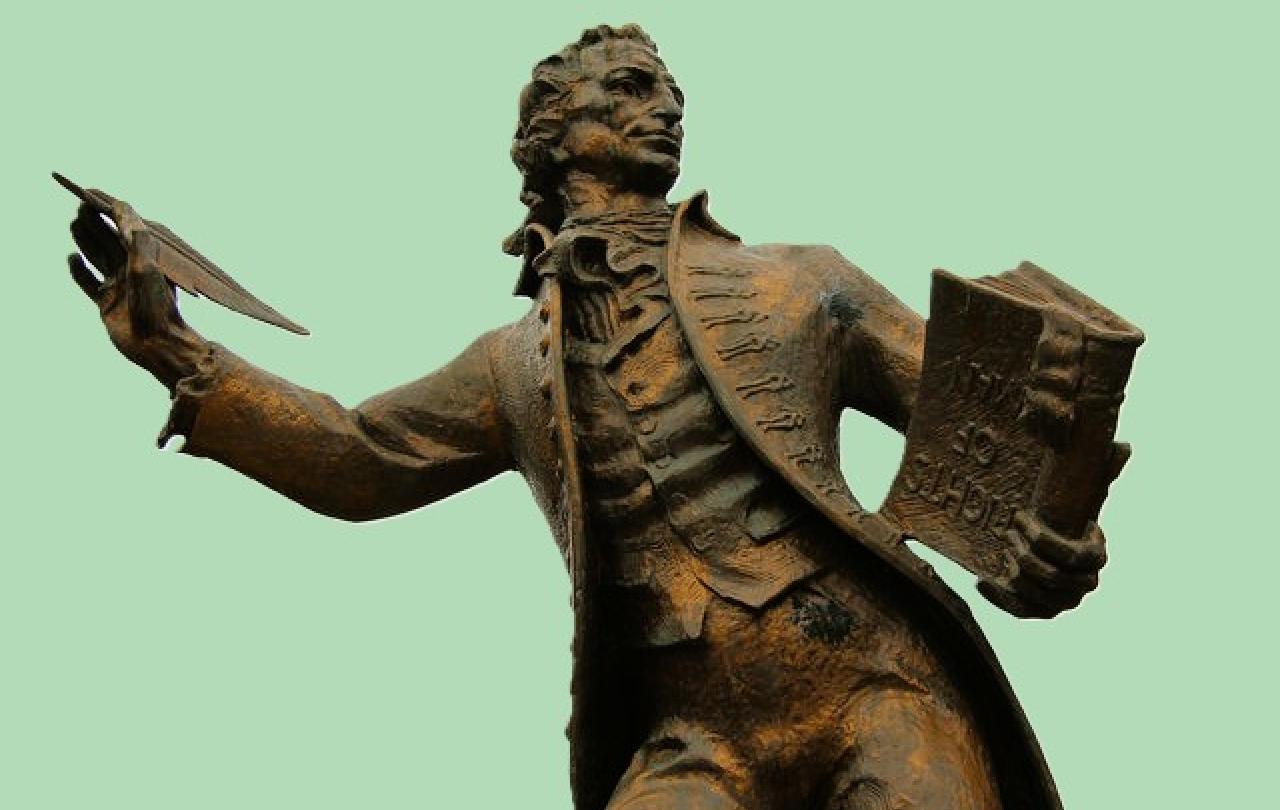
We live near Lewes in East Sussex, a town surrounded by genteel Conservatism but which inherits a certain edgy radicalism from Thomas Paine, whose utopian politics emerged there in the eighteenth century to inform both the French and American revolutions.
Paine haunts Lewes and his paraphernalia are everywhere. Walk the streets and it won’t be long before you spot posters quoting his most famous lines, among them “My country is the world and my religion is to do good”, from his seminal work Rights of Man.
He was a vicious critic of all organised religion, leading to the widespread assumption that he was an atheist. More accurately, he was a deist, a believer in a God who could and would deliver a global redemption of humankind, if we could and would only work towards that. The bit that’s most often left out of that famous quote is the phrase: “… all mankind are my brethren.”
Sometimes it takes a prophetic voice from outside mainstream religion to point us towards a world peace and a concord that seems beyond our faithful grasp. As ultra-nationalism is the go-to political ideology of our age, it’s such a voice that demonstrates that these populist creeds are the very antithesis of Paine’s globalist utopia.
There are tinpot nationalists throughout the world – Erdogan of Hungary, Meloni of Italy, Bolsonaro of Brazil, the list goes on – but it’s the superpowers that demonstrate most starkly the contrast between the narrow, inward and dark heart of ultra-nationalism and the generous, outward and illuminated vision of the globalist revolutionary.
It’s not just the contrast between what we currently have on the world stage and what we could have that’s remarkable, it’s the similarities between the psyches and prejudices of the ultra-nationalist super-powers, all of which sacrifice any worldview they might hold on the altar of their homeland self-interest. Take Russia, Israel and the United States. Don’t even start me on China.
Vladimir Putin’s Russia is embarked on an imperial expansionism that is positively tsarist. The attempted annexation of Ukraine is only the start, before reclaiming what are purported to be “Russian” state assets in the Baltics and beyond. Putin channels Peter the Great. This isn’t just demented desire for historical legacy, it speaks at home to the restoration of the motherland.
It’s the same incentive for Benjamin Netanyahu in Israel. Only continuing to oppress and purge the Palestinian state from its lands can the homeland of Israel be protected. It is precisely to satisfy the ultra-nationalists behind him that pushes him forward.
President Donald Trump in the US isn’t the peacemaker he fantasises about. To “make America great again” he has to put “America first”. This is about satisfying the baying boot boys that form the sump of Trump’s power base. Americans must live high on the hog at the expense of the rest of the world. Hence tariff wars, watch-the-lady trade deals and pan-arctic territorial aspirations.
This is not to say that peoples are to live without homelands. But it is precisely to tell us to be generous with them, to be good neighbours and to govern self-sacrificially.
What these three world leaders absolutely have in common is a worldview that predicates itself on satisfaction of nationalism at home that has to be paid for with suffering elsewhere. What they tell us is the exact opposite of Paine: “My borders are my country and my religion is to do harm.” They might add the sub-phrase: “… only my people are my brethren.”
The difference between patriotism and nationalism spawns many aphorisms. One such is that patriotism prioritises love of one’s own people and nationalism prioritises hate for other people other than one’s own. That’s not quite right, because both still hold the primacy of one’s own people over others, while Paine inferred the primacy of all people.
That’s what ultimately gives religious fervour to his voice. His declared detestation of religion seemingly ignores the tenets of the three Abrahamic faiths of the world, which have in common the welcome of the stranger, a duty to the poor and equality of all before God.
These commandments extend patriotism to love of all people. And, rigorously, they leave no room for nationalism at all. As for ultra-nationalism, we’re in the territory of abomination and sacrilege.
This is not to say that peoples are to live without homelands. But it is precisely to tell us to be generous with them, to be good neighbours and to govern self-sacrificially. That’s admittedly a tall order, but these are qualities that can either be identified in or imported into national identities as diverse as the American Constitution and Zionism.
The methodology for that is, admittedly, demanding. But it requires the ability to look outwards to the world, rather than inwards towards nation. And that becomes a religious vocation.
Our instincts, as nations, are inwards, but our callings our outwards. Sometimes it takes an outsider, like Paine, to point us in the right direction, outwards.
Celebrate our 2nd birthday!
Since March 2023, our readers have enjoyed over 1,000 articles. All for free. This is made possible through the generosity of our amazing community of supporters.
If you’re enjoying Seen & Unseen, would you consider making a gift towards our work?
Do so by joining Behind The Seen. Alongside other benefits, you’ll receive an extra fortnightly email from me sharing my reading and reflections on the ideas that are shaping our times.
Graham Tomlin
Editor-in-Chief





